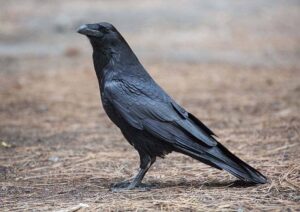During the first sunny days of March you can see ravens perform courtship flights, chasing each other, dropping from on high in falcon-like swoops, one bird close behind the other. This is combined with rolls and loops while they passively defend a nesting territory. Paired ravens may be seen sitting side by side preening each other’s feathers, touching bills and vocalizing, with seeming affection. Often they forage in pairs, the two birds sometimes cooperating to flush out prey.
Ravens first breed at 3 or 4 years of age and mate for life. By mid-March adult pairs are roosting near their nesting locations. They may use the same nest site year after year, adding material on top of old nests. Both sexes help build a bulky basket of large sticks and twigs, with a deep depression in the center lined with grass, bark strips, moss and animal hair. These nests can be found on cliff ledges or atop a large conifer.
The female lays from three to seven eggs and while she incubates she is fed by the male. The chicks hatch after about three weeks and grow quickly. Both parents feed the young by regurgitating food and water stored in a throat pouch. In the Interior, young ravens leave the nest by the first week of June. They can live a long life in the wild; one captive bird died of old age at 29 years. The common raven (Corvus corax) is a member of a family of birds known as the Corvidae, which includes jays, magpies and crows, all which are robust, perching songbirds, even though there is an absence of any real music. The raven is the largest species of songbird and largest all-black bird in the world. There is no mistaking the raucous call of the raven: the deep, resonant sound is its trademark; however, the raven can produce an assortment of more than 30 distinct vocalizations. Rather than a song, their sounds are more like talking.
Scientists believe much of the raven’s behavior suggests a highly developed mentality, and the corvids have been referred to as the most highly evolved of birds. Mystical powers have been attributed to the raven as far back as ancient Greece. According to the mythology of some Alaska Native peoples, Raven brought the daylight, hung the moon, acquired fire and made the rivers flow. He created people and then tricked them out of their food in a variety of clever and devious ways. This intelligent and remarkably adaptable bird, living as a scavenger and predator, can survive at all seasons in surroundings as different as hot desert and high Arctic tundra. In Fairbanks, the raven is an all-year resident, who feeds on carrion in the winter and does not disdain garbage dumps, and on wind-blown hillsides he picks cranberries and crow-berries.
Ravens do not undertake long migrations like many birds, but breeding birds usually relocate for nesting each year. When not breeding they may travel 30 to 40 miles each day from roost to daytime feeding areas. As many as 800 ravens have been seen in one roost near Fairbanks. Their graceful play in the air currents, the different calls uttered in succession as though meant for song, and their cultural roles evoke strong emotion from humans who take the time to enjoy them.




